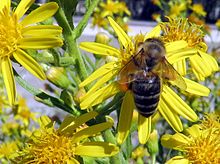Greek bee
| Apis mellifera cecropia | |
|---|---|

| |
| Scientific classification | |
| Domain: | Eukaryota |
| Kingdom: | Animalia |
| Phylum: | Arthropoda |
| Class: | Insecta |
| Order: | Hymenoptera |
| Family: | Apidae |
| Genus: | Apis |
| Species: | |
| Subspecies: | A. m. cecropia
|
| Trinomial name | |
| Apis mellifera cecropia Kiesenwetter, 1860
| |
Apis mellifera cecropia, the Greek bee, is a subspecies of honey bee that is native to southern Greece and southern Albania.[1][2] It is very similar to Apis mellifera ligustica, or the Italian bee. It is favored for its extreme gentleness and lack of tendency to swarm. This species prefers warm temperatures, owing to its Mediterranean origin, and cannot survive in northern Europe's cooler climate.[citation needed] Due to that, they are seldom kept outside of southern Greece.[citation needed]
Life cycle
Greek bees generally tend to build up very quickly in the spring, with the queens being very prolific, resulting in strong hives. They also tend to make quite a lot of honey, but only in Mediterranean climates.[citation needed]
References
- ^ Crane, Eva (1999). The world history of beekeeping and honey hunting. Taylor and Francis. p. 196. ISBN 978-0-415-92467-2.
- ^ Dedej, S.; Biasiolo, A.; Piva, R. (1996). "Morphometric and alloenzymatic characterisation in the Albanian honeybee population Apis mellifera L" (PDF). Apidologie. 27 (3): 121–131. doi:10.1051/apido:19960301.